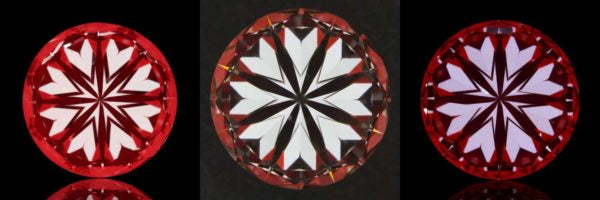
Buyers Guide: GIA Hearts and Arrows diamonds
“My fiancé is adamant that she wants a GIA Excellent cut diamond. At the same time, we’ve been doing a lot of research and have concluded that we want a hearts and arrows diamond. Does Brian Gavin offer any GIA hearts and arrows diamonds? It seems like all the Brian Gavin Signature hearts and arrows diamonds are graded by the AGS Laboratory. Is there a reason for that? Isn’t the GIA more reliable? We’ve found several GIA certified hearts and arrows diamonds, would you mind taking a look at them and telling me what you think? By the way, we’re looking for 1.70 – 2.00 carats, D-E-F color, VS-2+ clarity with no fluorescence.”
AGSL vs GIA Gemological Laboratories:
For all intents and purposes, we find the grading standards of the AGS and GIA gemological laboratories to be comparable for the basics, such as diamond carat weight, clarity, color, fluorescence, polish and symmetry grading.
However, there is a distinct difference in how the two laboratories round off the measurements, and how they judge diamond cut quality. Both laboratories take eight measurements per section, and then add them together and divide that sum by eight to determine the average measurements for the different sections of the facet structure.
The AGS Laboratory publishes those average measurements on the proportions diagram featured on their diamond quality documents. However, the GIA further rounds some of those average measurements off to the nearest half a degree, and sometimes as much as 5% (which is huge if you stop to think about it).
Why you should insist on AGS ASET:
 The AGS Laboratory uses Angular Spectrum Evaluation Technology (ASET) to measure the brightness exhibited by the diamond. This simple fact is the reason why most diamond cutters choose to send their production to the GIA, where it will not be subjected to ASET as a determining factor of the cut grade.
The AGS Laboratory uses Angular Spectrum Evaluation Technology (ASET) to measure the brightness exhibited by the diamond. This simple fact is the reason why most diamond cutters choose to send their production to the GIA, where it will not be subjected to ASET as a determining factor of the cut grade.
Take a good look at the ASET image on the lab report for this 1.738 carat, F-color, VS-2 clarity, Black by Brian Gavin hearts and arrows round diamond. Do you see all that red? To put it simply, that means that this diamond is going to be incredibly bright. And don’t be fooled by dealers who provide an ASET image of a GIA graded diamond taken through the scope, because that is not really the same thing.
This ASET Scope image is actually a composition which is based upon light performance data obtained while the diamond was being measured while in rotation, at multiple stop points. That provides much more detail than a simple photograph of the diamond taken in the straight-up 90 degree position, where it is actually always going to look its best.
But the reality is that you’re rarely going to look at your diamond in the straight-up, 90 degree position. You’re going to be seeing your diamond while it is in motion, which is why the light performance should be measured while the diamond is in motion.
“It’s all in the hearts” – Brian Gavin:
 Brian Gavin is well known for saying “It’s all in the hearts” when talking about light performance and sparkle factor. That is because the precision of the hearts pattern determines the number of virtual facets (internal reflections of light) and the intensity of the sparkle.
Brian Gavin is well known for saying “It’s all in the hearts” when talking about light performance and sparkle factor. That is because the precision of the hearts pattern determines the number of virtual facets (internal reflections of light) and the intensity of the sparkle.
This is the hearts pattern exhibited by the 1.738 carat, F-color, VS-2 clarity, Black by Brian Gavin Signature round diamond. Notice how the hearts and consistent in size and shape. This is going to produce sparkle which is evenly distributed throughout the diamond, as well as being more vivid.
Creating the hearts is no easy feat. Each heart is comprised of two halves, which consist of light which is reflecting off the pavilion main facet on one side of the diamond, over to the lower girdle facets on the other side of the diamond.
In order to achieve this type of incredible optical precision, every facet has to be carefully aligned with every other facet on the diamond. In addition, the facets all must be the same size and shape, and the proportions of the diamond must be just right.
Hearts & Arrows, Rabbit Ears & Lawn Darts:
Without getting into the nitty gritty details of each of the diamonds which you asked me about, let’s just look at the images provided:

As you can see, the patterns exhibited by these GIA Excellent cut diamonds don’t look anything like the hearts patterns exhibited by Brian Gavin Signature round diamonds. The reason is simple enough, these diamonds simply weren’t cut to the same high degree of optical precision.
As a result, it is highly unlikely that these GIA Excellent cut diamonds will exhibit light performance comparable to a Brian Gavin Signature hearts and arrows round diamond.




















